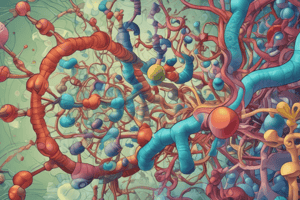Podcast
Questions and Answers
Which of the following is NOT a function of carbohydrates in the human body?
Which of the following is NOT a function of carbohydrates in the human body?
- Sparing protein from being used as energy
- Acting as a storage form of energy
- Maintaining healthy blood pressure (correct)
- Providing energy for the brain
Which type of carbohydrate is broken down into simple sugars by enzymes in the mouth and small intestine?
Which type of carbohydrate is broken down into simple sugars by enzymes in the mouth and small intestine?
- Monosaccharides
- Oligosaccharides
- Polysaccharides (correct)
- Disaccharides
What is the primary source of carbohydrates in animal-based foods?
What is the primary source of carbohydrates in animal-based foods?
- Meat and poultry
- Eggs
- Honey
- Milk and dairy products (correct)
Which of the following is an example of a complex carbohydrate?
Which of the following is an example of a complex carbohydrate?
What is the role of carbohydrates in nucleic acids?
What is the role of carbohydrates in nucleic acids?
What happens to excess glucose in the body?
What happens to excess glucose in the body?
Flashcards are hidden until you start studying
Study Notes
Classification of Carbohydrates
- Simple carbohydrates (monosaccharides):
- Glucose (dextrose or grape sugar)
- Fructose (fruit sugar)
- Galactose (milk sugar)
- Complex carbohydrates (polysaccharides):
- Disaccharides:
- Sucrose (table sugar)
- Lactose (milk sugar)
- Maltose (malt sugar)
- Polysaccharides:
- Starch (found in plants)
- Glycogen (found in animals)
- Cellulose (found in plant cell walls)
- Chitin (found in fungi and exoskeletons of crustaceans)
- Disaccharides:
Functions of Carbohydrates
- Primary source of energy for the body
- Spare protein from being used as energy
- Provide fiber, which is essential for digestive health
- Act as a storage form of energy (glycogen)
- Component of nucleic acids, such as DNA and RNA
- Play a role in the structure of cells and tissues
Sources of Carbohydrates
- Plant-based sources:
- Fruits
- Vegetables
- Grains (bread, pasta, rice)
- Legumes (beans, lentils)
- Animal-based sources:
- Milk and dairy products
- Honey
Carbohydrate Metabolism
- Digestion: broken down into simple sugars by enzymes in the mouth and small intestine
- Absorption: absorbed into the bloodstream through the walls of the small intestine
- Transportation: transported to cells throughout the body via the bloodstream
- Utilization: used by cells for energy, growth, and repair
- Storage: excess glucose is stored as glycogen in the liver and muscles
Classification of Carbohydrates
- Simple carbohydrates (monosaccharides) include glucose, fructose, and galactose.
- Complex carbohydrates (polysaccharides) consist of disaccharides and polysaccharides.
- Disaccharides include sucrose, lactose, and maltose.
- Polysaccharides include starch, glycogen, cellulose, and chitin.
Functions of Carbohydrates
- Carbohydrates are the primary source of energy for the body.
- They spare protein from being used as energy.
- Fiber, a type of carbohydrate, is essential for digestive health.
- Glycogen is a storage form of energy.
- Carbohydrates are components of nucleic acids, such as DNA and RNA.
- They play a role in the structure of cells and tissues.
Sources of Carbohydrates
- Plant-based sources of carbohydrates include fruits, vegetables, grains, and legumes.
- Animal-based sources of carbohydrates include milk, dairy products, and honey.
Carbohydrate Metabolism
- Carbohydrates are broken down into simple sugars through digestion by enzymes in the mouth and small intestine.
- Simple sugars are absorbed into the bloodstream through the walls of the small intestine.
- The bloodstream transports carbohydrates to cells throughout the body.
- Cells use carbohydrates for energy, growth, and repair.
- Excess glucose is stored as glycogen in the liver and muscles.
Studying That Suits You
Use AI to generate personalized quizzes and flashcards to suit your learning preferences.




